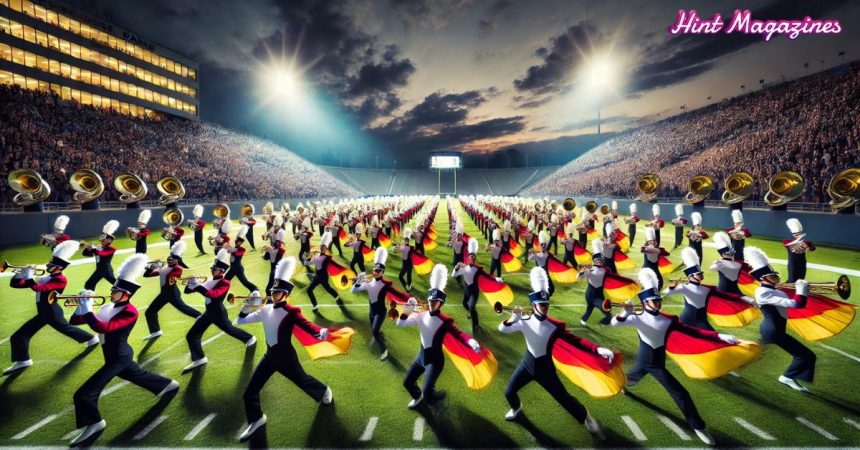Movement One is used in marching bands to describe the first piece of the marching band show. This is where the performance starts, naming the tone and defining the first impression. When Movement One is played, it is usually packed with music, steps, and visuals that make the audience can’t wait to be captivated. It is also an essential part of the performance and is supposed to encourage the audience’s involvement in the storyline or theme show.
Understanding the Role of Movement One in a Marching Band Show
Movement One is the foundation of the performance. The first few minutes are designed to establish the show’s mood: excitement, suspense, or drama. This segment often includes introductory music, dynamic formations, and choreographed visuals that showcase the band’s technical skills.
Why Movement One Matters
- Setting the Mood: The whole performance is set by Movement One, which is an emotional tone and reflects the mood.
- Establishing the Theme: Sometimes, it foreshadows the show’s theme to the audience and tells them what’s coming.
- Creating Engagement: The move attracts the audience’s attention and builds our anticipation of the rest of the show.
What Does Movement One Typically Include?
Movement One can vary based on the band’s theme, the music chosen, and the marching style. However, it usually contains these core elements:
- Introductory Music: Often bold and energetic, creating an impactful entrance.
- Visual Formation: Unique shapes or designs created by the band members’ positions on the field.
- Colour Guard: Incorporating flags, rifles, or sabres to add visual dynamics.
- Percussion Elements: The drumline sets the beat, creating rhythm and building anticipation.
- Choreography: Precision movements and coordinated steps that display the band’s unity.
Key Focus Areas in Movement One
Movement One is generally intended to be impressive yet approachable. It often incorporates accessible and enjoyable music, aiming to reach everyone in the audience. The choreography is also typically less complex in Movement One, as it introduces the more intricate movements that follow.
Preparing for Movement One: Training and Rehearsals
Marching bands spend countless hours practising, and Movement One requires special attention. Since it’s the first thing the audience will see, getting every detail right is essential.
Rehearsal Routines
- Music Practice: Band members practice the musical piece extensively, focusing on timing, transitions, and overall flow.
- Marching Drills: Movements, steps, and formation shifts are rehearsed to ensure coordination.
- Visuals and Props: The colour guard practices with flags and props to ensure synchronization with the band.
Rehearsals ensure that every member knows their role and can execute it flawlessly. Movement One is typically rehearsed until it becomes second nature for each performer.
Why Precision is Key in Movement One
In marching bands, precision is everything. Movement One is the first opportunity for the band to show off its skills, and any errors will be noticeable. This part of the performance requires a blend of music and movement that can be challenging to perfect.
Key Elements of Precision
- Timing: Every beat and step must be perfectly timed.
- Formations: Band members must accurately hit their positions to maintain the visual shape.
- Coordination with the Color Guard: Smooth integration of colour guard elements is essential for a cohesive performance.
Movement One is the ultimate showcase of teamwork. Every band member must collaborate to create a polished opening, from the musicians to the colour guard.
Movement One vs. Other Movements in a Marching Band Show
But marching band show parts are generally broken into a few movements, each meant to layer on top of the last. Movement One stands out because it’s the opening act with a specific purpose: Something grabbing attention and treading to tone.
Differences Between Movement One and Other Movements
- Introduction vs. Development: Movement One introduces the show, while later movements develop the theme or story.
- Complexity: Movements following the first may be more complex, allowing the band to showcase advanced skills.
- Energy Levels: Movement One is often energetic, while other movements might vary in tempo and intensity.
Each movement in a marching band show plays a unique role, but Movement One is responsible for establishing the audience’s first impression.
Common Themes for Movement One
Movement One often reflects a specific theme, which could be anything from a historical event to a modern-day concept. Here are some popular themes for Movement One in marching band shows:
- Patriotic Themes: Music and visuals reflecting national pride.
- Historical Narratives: Re-enacting historical events or moments.
- Fantasy and Adventure: Themes from popular books, movies, or legends.
- Nature and Seasons: Using music and movements to depict the beauty of nature.
- Emotional Themes: Expressing a particular feeling, like joy or sorrow.
These themes add depth to the performance and help make Movement One memorable.
Trending FAQs About
Let’s address some commonly asked questions about Movement One in a marching band:
What does “Movement One” mean in a marching band performance?
Movement One is the first part of a marching band show. It’s a carefully crafted performance introduction that sets the theme, mood and pace. It’s important because it catches the audience’s attention immediately.
How is Movement One different from other movements in a marching band show?
While Movement One introduces the show and sets the tone, other movements dive deeper into the theme, adding complexity and variations. Each movement builds upon the previous one, with Movement One being the foundation.
What skills are essential for performing Movement One in a marching band?
Essential skills include musical timing, precision marching, coordination, and synchronization with the colour guard. Since this part of the performance is the audience’s first impression, each element must be executed flawlessly.
How do marching bands choreograph Movement One?
Bands often spend months choreographing Movement One. Directors and choreographers design the formations, musical elements, and visuals to align with the theme, ensuring everything is in sync for maximum impact.
Why is Movement One important in setting the tone for a marching band performance?
Movement One creates the first impression and establishes the mood. It makes the audience curious and connived about how it will be done.
Conclusion
The start of a performance is different from the movement in a marching band is about. This is the entry point of a story told through music, choreography, and visuals. Movement One grips the audience with care and rehearsal and finally has its show; the timing is perfect!





